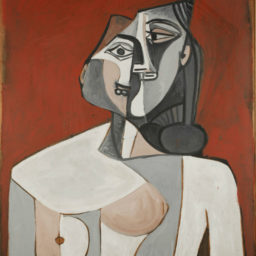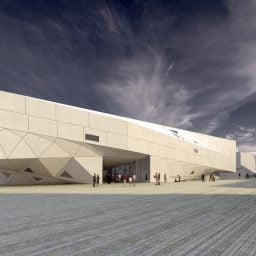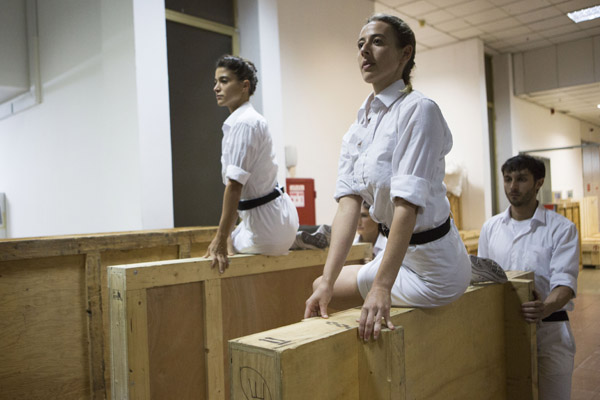
Public Movement, from the exhibition “National Collection” at the Tel Aviv Museum of Art
Photo: Oz Moalem, courtesy Public Movement
The current exhibition at the Tel Aviv Museum of Art, entitled “Public Movement: National Collection,” is a durational performance carried out by the 11-strong entity Public Movement across the different wings of the museum.
But before discussing the show, it is important to note that the performance cannot be fully understood without taking the following into account: Which state was proclaimed in a room of the private house of the first mayor of a “city without state,” Tel Aviv, a room that then functioned as an art museum and was therefore surrounded by artworks? And today, which state sees its two current major art museums—Tel Aviv Museum of Art and The Israel Museum—one facing the headquarters of the ministry of defense and the other facing the parliament, respectively? Which museum has paintings marked with different dots according to their order of evacuation to its shelter in case of a war?
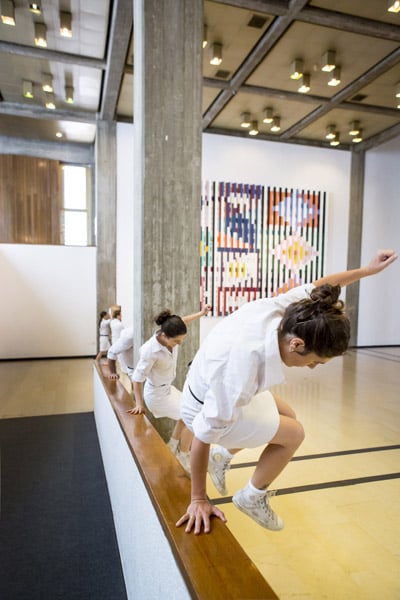
Public Movement, from the exhibition “National Collection” at the Tel Aviv Museum of Art
Photo: Kfir Bolotin, courtesy Public Movement
These are pivotal elements that inform the controversial project of Public Movement. This exceptional entity appropriates the language of political parties, propaganda, nationalism, dance, and the army among others, in order to investigate those gray areas of reality that exist within the power structures dominating the notion of democracy at its ultimate state.
It’s a stage that sees the dawn of representation, often substituted by either identification or appropriation, in which the tools of democracy—such as voting, marching, protesting—seem to have become mere folklore.
To do so, Public Movement has created two moments that take place inside the museum: Debriefing Session (2015) is a one-on-one experience in which an agent of the movement explains details about Palestinian art produced before the creation of the state of Israel, in 1948; and National Collection (2015) in which members of the movement take the audience on a half-stroll, half-guided tour through the public and private spaces of the museum, creating awareness for the symbolic power of artworks—their presence, movements, and existence—within the current political reality.
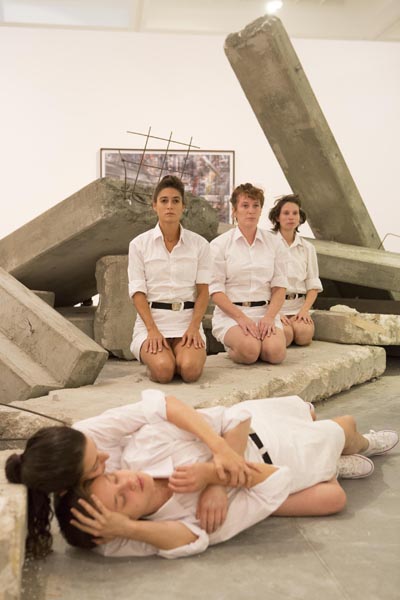
Public Movement, from the exhibition “National Collection” at the Tel Aviv Museum of Art
Photo: Kfir Bolotin, courtesy Public Movement
As local as these considerations might seem, “Public Movement: National Collection” can be taken as a universal case study, a filter that can be used to analyze how impossible it has become to create moments that undermine the status quo; moments of resistance toward the system—whether it be embodied by the government, the mainstream, the institution, or the museum—which has turned into a liquid blob embracing and at the same time strangling all of us.
Trying to historicize the work of Public Movement, one could argue that, if Marcel Duchamp invented a new form of art making, Guy Debord turned commercial material into cultural criticism, and Sherrie Levine re-photographed photographs by male photographers, Public Movement appropriates, incorporates and re-contextualizes choreographies, flags, uniforms, and anthems. In other words, I would define their movements as post-readymade, détournement-like and after-appropriative.
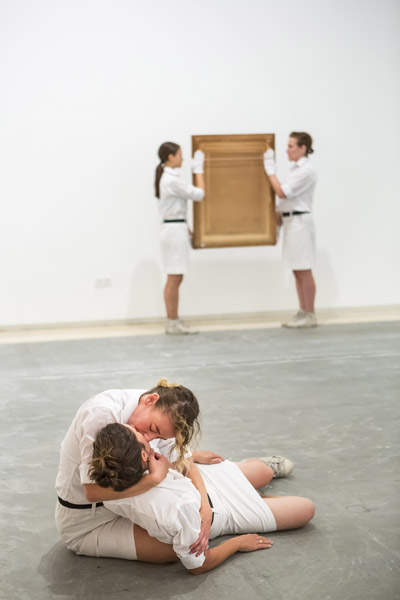
Public Movement, from the exhibition “National Collection” at the Tel Aviv Museum of Art
Photo: Kfir Bolotin, courtesy Public Movement
Aware of this situation and conscious of the historical connections, Public Movement can be seen as the initiator of a series of controversial actions that are truly seductive—I myself thought about joining the movement. And yet, they can be deeply repulsive, too, especially when trying to frame delicate issues such as the Palestinian condition—where related facts, issues, and ideas are univocally distributed (all members of the movement are Israelis)—or the mysterious and enigmatic force behind the creation of artworks, here often reduced to mere objects or props used to support specific political theories.
Furthermore, Public Movement’s position can sometimes lead to reduction. For instance, the level of precision of the agent leading a Debriefing Session is not entirely convincing, while the choreographies, uniform, muscular bodies, and features of its performing members do not always match the expectations of perfection and proficiency.
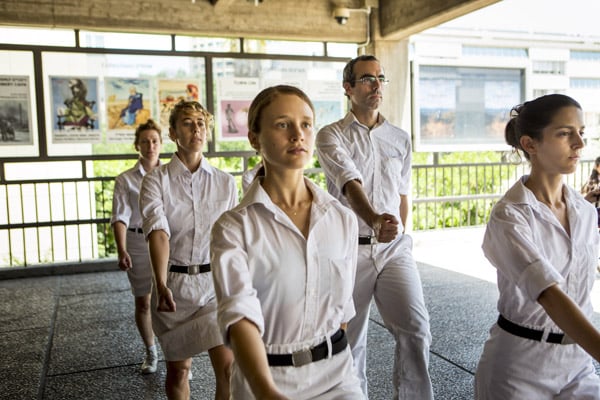
Public Movement, from the exhibition “National Collection” at the Tel Aviv Museum of Art
Photo: Kfir Bolotin, courtesy Public Movement
But, speaking in favor of the healthy reduction brought by a conceptual approach, we can mention the following example: while Joseph Kosuth’s seminal work One and Three Chairs (1965) might appear to an expert of linguistics as the simplest application of Ferdinand de Saussure’s theory of the sign, with its signifier (form) and its signified (meaning), when transplanted into the field of art it becomes a seminal moment in the history of art; very similarly, in the eyes of a dancer or soldier, Public Movement’s embodiments can appear quite poor while the transportation of these very same embodiments to the museum—regardless of their quality—is already enough because the aim is not to bring “good dance” or “good marches” but rather to trigger challenging the assumption of what a museum is and how art behaves or misbehave.
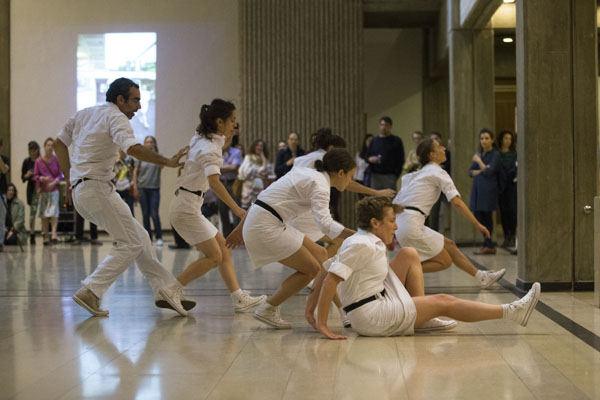
Public Movement, from the exhibition “National Collection” at the Tel Aviv Museum of Art
Photo: Oz Moalem, courtesy Public Movement
In other words, stating that Public Movement’s embodiments are not perfect is like saying Picasso’s portrait of Dora Maar doesn’t look like her. Whichever way we answer these only apparently futile ruminations, the importance and uniqueness of “National Collection” is out of question, especially—but not only—when understood within the context of Israel, in which contemporary visual art rarely deals with collectivity, multiplicity, and performativity.
And even less so within the context of a rather old-fashioned institution such as The Tel Aviv Museum of Art which, through this commitment to the project, has shown the desire to question its very premises, to open its doors, basements, and crates, and to show its vulnerable side, inaugurating an alternative way of exhibition making.
It’s hard to say whether this is genuine openness or a new sophisticated Public Relations strategy. The answer, a bittersweet one, probably lies in the middle.
“Public Movement: National Collection” takes place at the Tel Aviv Museum of Art from October 28 – December 10.








